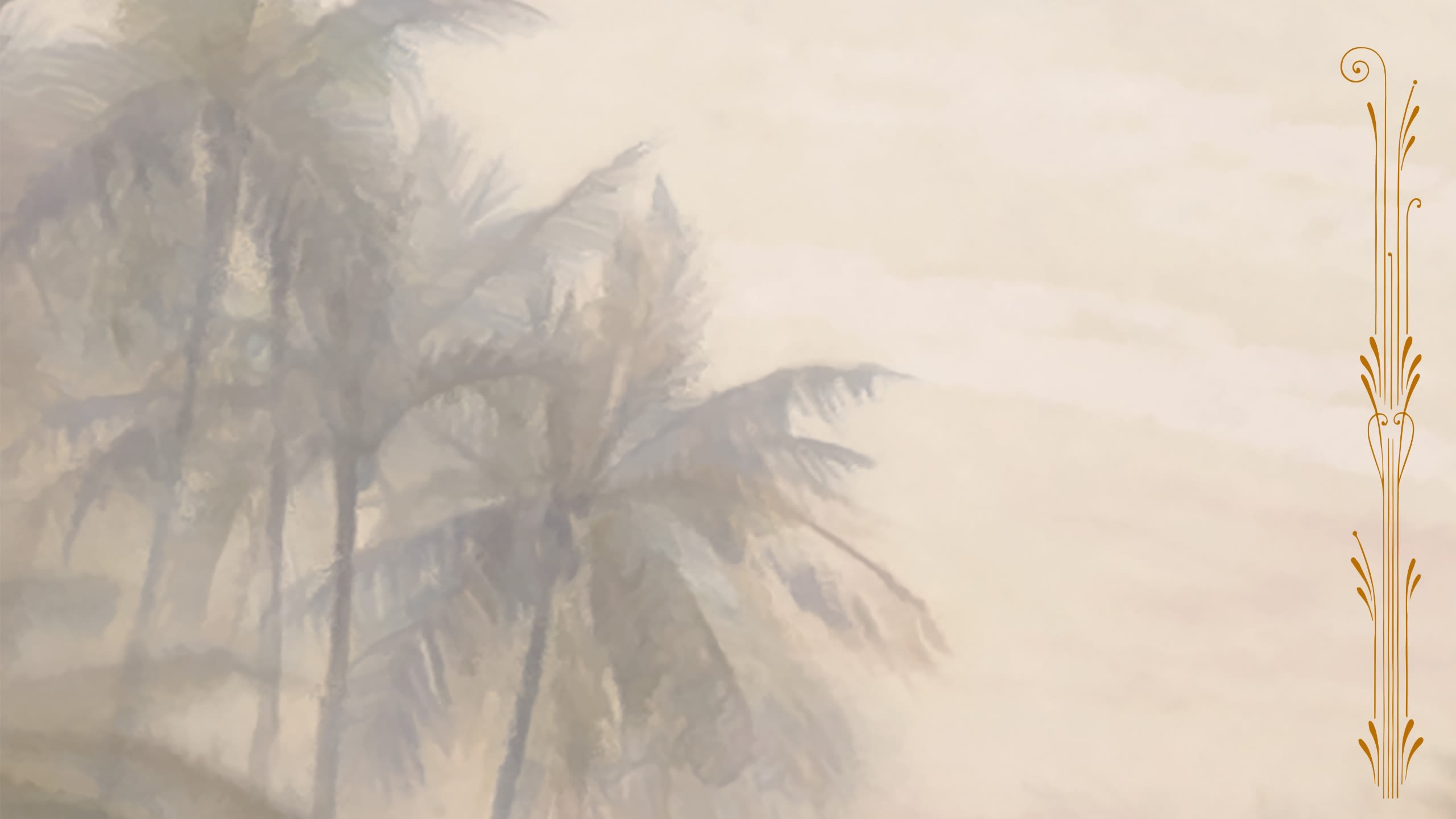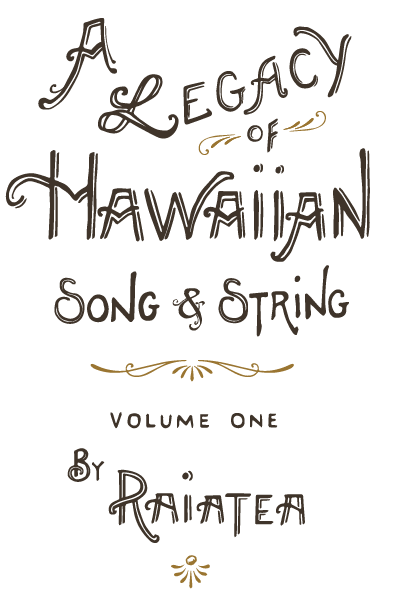
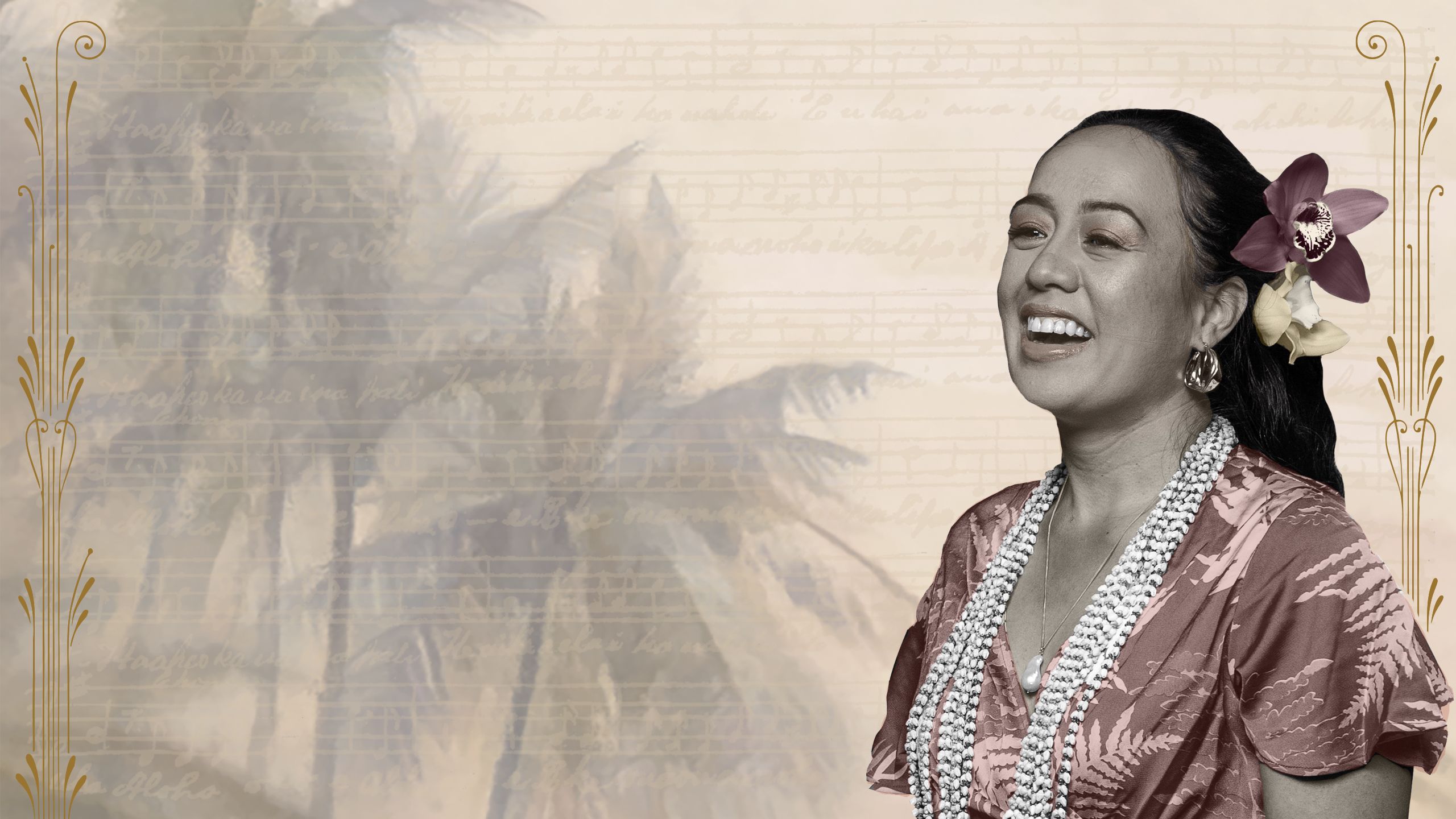

Hoʻolaʻilaʻi nā manu i ka leo o ke kāhuli leo leʻa o uka o Hoʻolehua –– The birds are stilled in repose by the voice of the kāhuli shell of the uplands of Hoʻolehua
Let us pause a moment to recognize the singularity of this album, exceptional in all senses of the word. It is remarkably rare that we are offered a musical contribution comprised of such pristine vocals, superb poetry, and impeccable musicianship. The outcome is one of arresting beauty.
The music captured on this album is special, and will be remembered for generations to come. Raiatea’s voice rings clear as a bell, renewing the life of some of the most exemplary Hawaiian poetry composed in these islands, nestled effortlessly atop extraordinary instrumentation.
It is difficult to describe the emotion, the sentiment that tugs at one’s heart, when one experiences this moment of music-making that stings with the nostalgia of yesterday while at the same time carrying the promise of tomorrow. Raiatea’s music is transcendent of time and space, it harkens back to the past, it resonates in the present, it shapes the future.
It must be her talent, her poise, and her unique ability to vocalize a mele while presenting it in the moment during which it was composed, materializing the historical context with each lyric and note, each breath and lilt. Her audiences will delight in her song selections, lifted carefully from songbooks, sheet music, newspaper pages, and diaries, some tattered with age, and others, while newer, reflecting the same poetic mastery.
The exquisite lyricism is enhanced by the finest musicianship, listeners will appreciate the balance this album strikes between leo and pila, between voice and instrument, between strum and lilt. Mutually complementary, the instrumentation and vocalization pair with inimitable symmetry.
How felicitous it is that Raiatea has chosen to mark this moment by presenting mele that bridge time, honor tradition, and uphold the standard of excellence to which our aliʻi, kūpuna, and forebears strove, successfully as they did, in defining a musical culture and leaving a legacy we inherit today as the people of Hawaiʻi.
It is true when I say this album makes one hoʻolaʻilaʻi, it conceives within us a peace that brings us to pause, to be still, and to earnestly revel in each track, subdued as a manu o uka, a bird in the upland, listening to the sweet-voiced kāhuli of Hoʻolehua, enraptured by a soundscape so uniquely Hawaiian, the soundscape that is Hawaiʻi.
He mai, e nanea mai, e nā manu o uka, e hoʻolaʻilaʻi pū mai i ʻaneʻi –– Come, pass the time, o birds of the uplands, and find repose here.

- N. Haʻalilio Solomon
Honolulu, Hawaiʻi




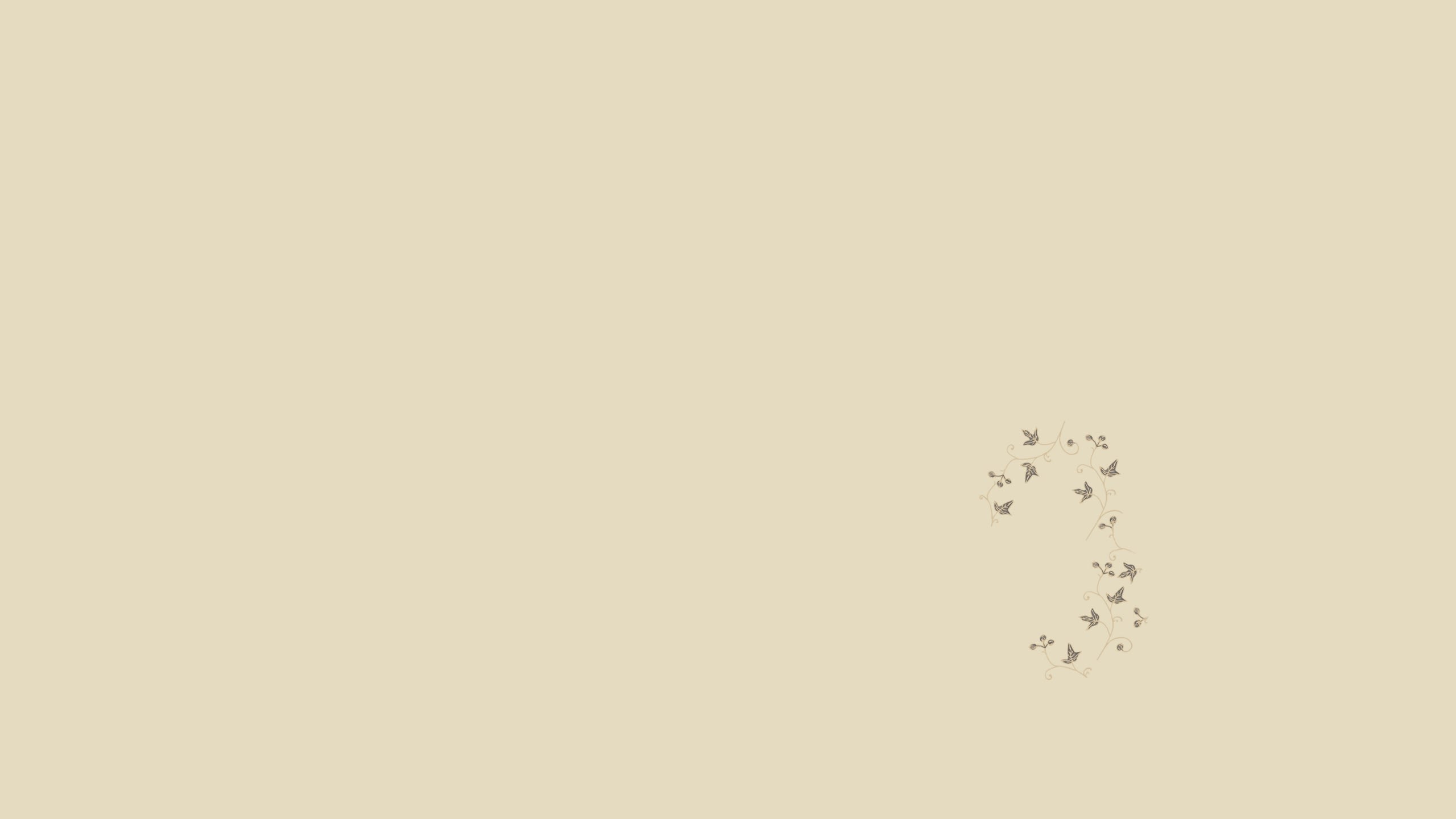
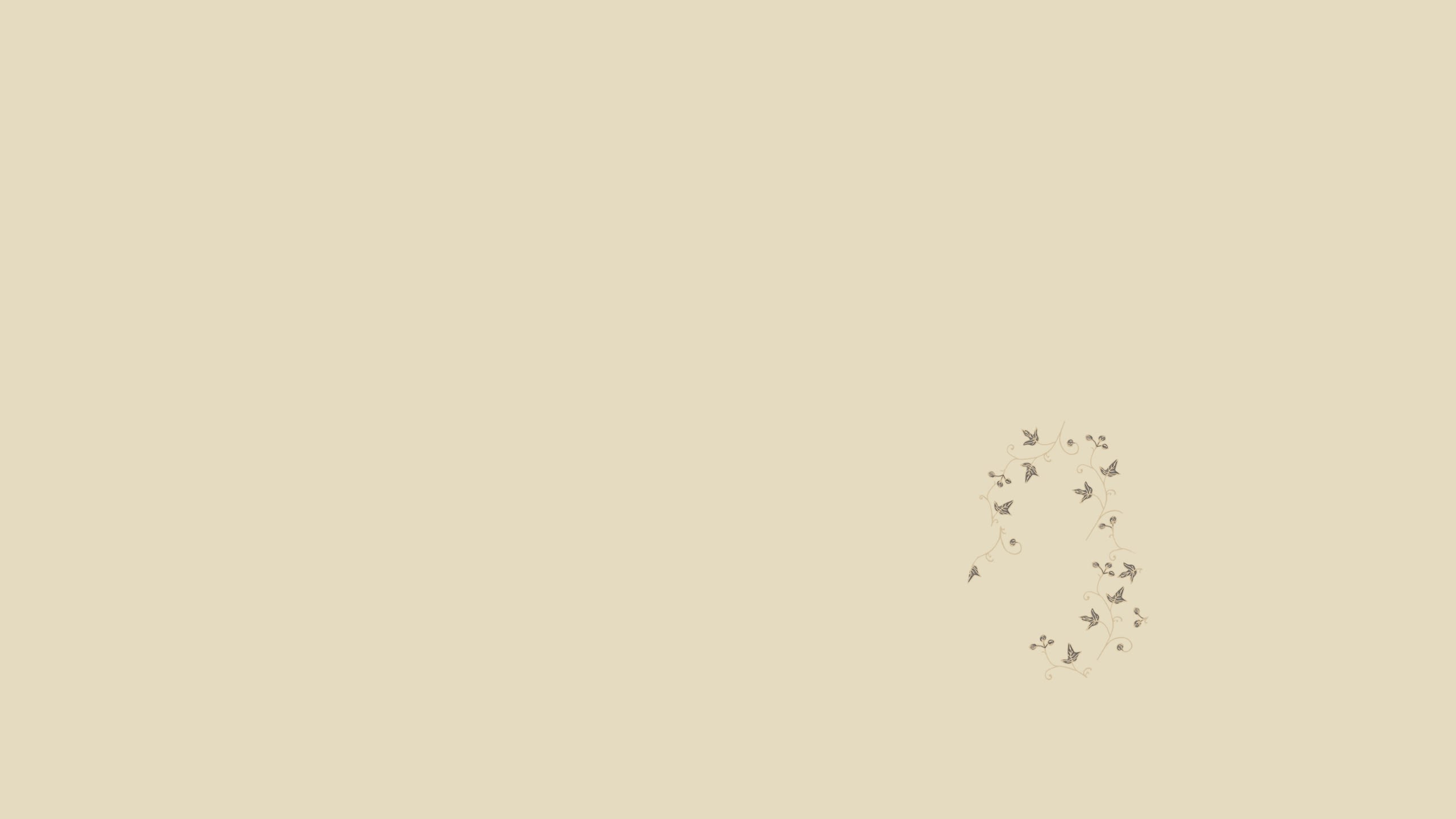


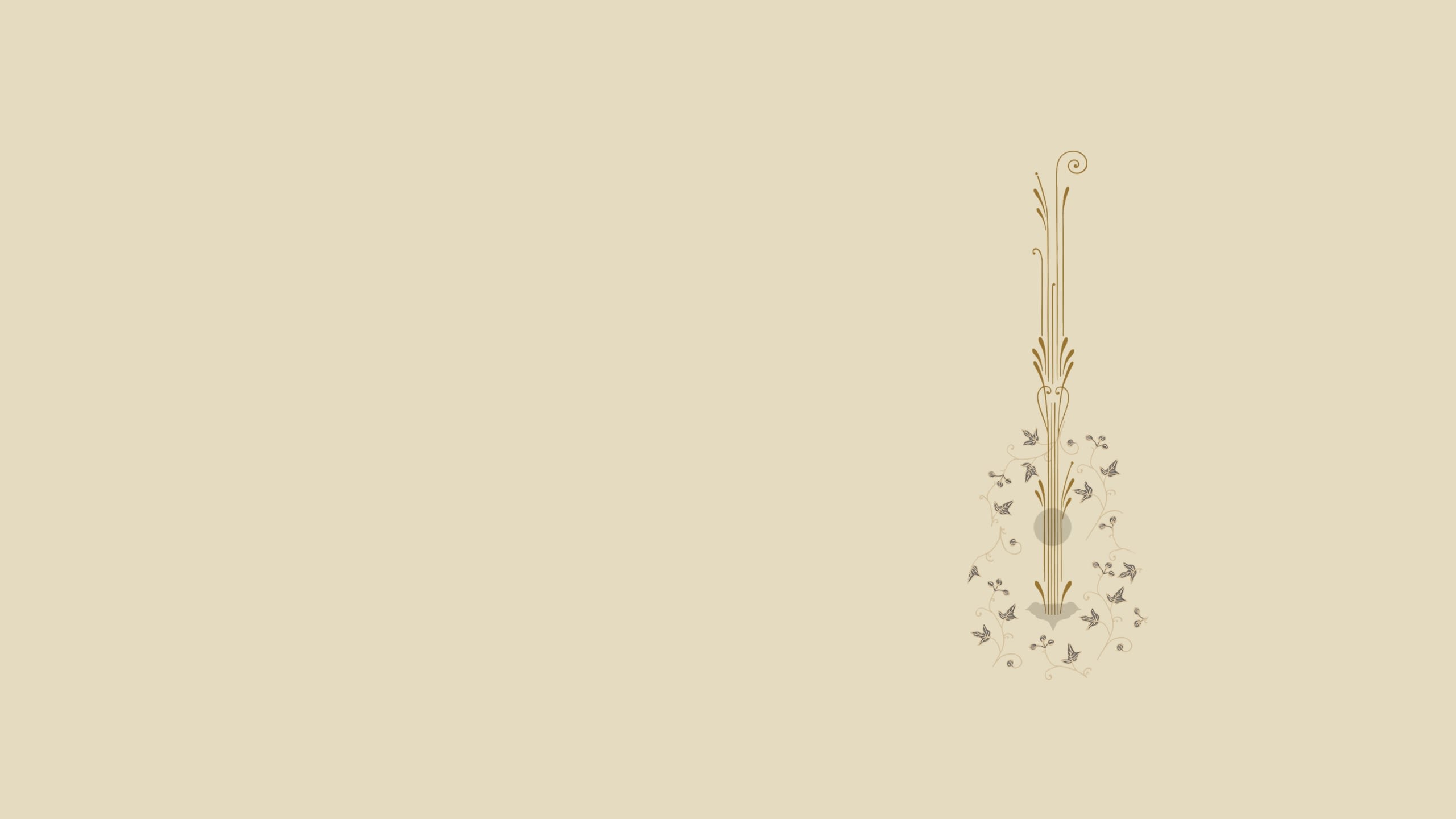
Lanakila Kawaihau
Originally composed as a mele hua inoa in which the first letter of each line proclaims “KAWAIHAU NANI”, Mekia Kealakai fashions a colorful moment in history into song to honor the Kawaihau Glee Club. The elusive poetry alludes to desire and attraction, singing and recreational activity, and the reasons for which members of the club boasted about their loyalty to it.
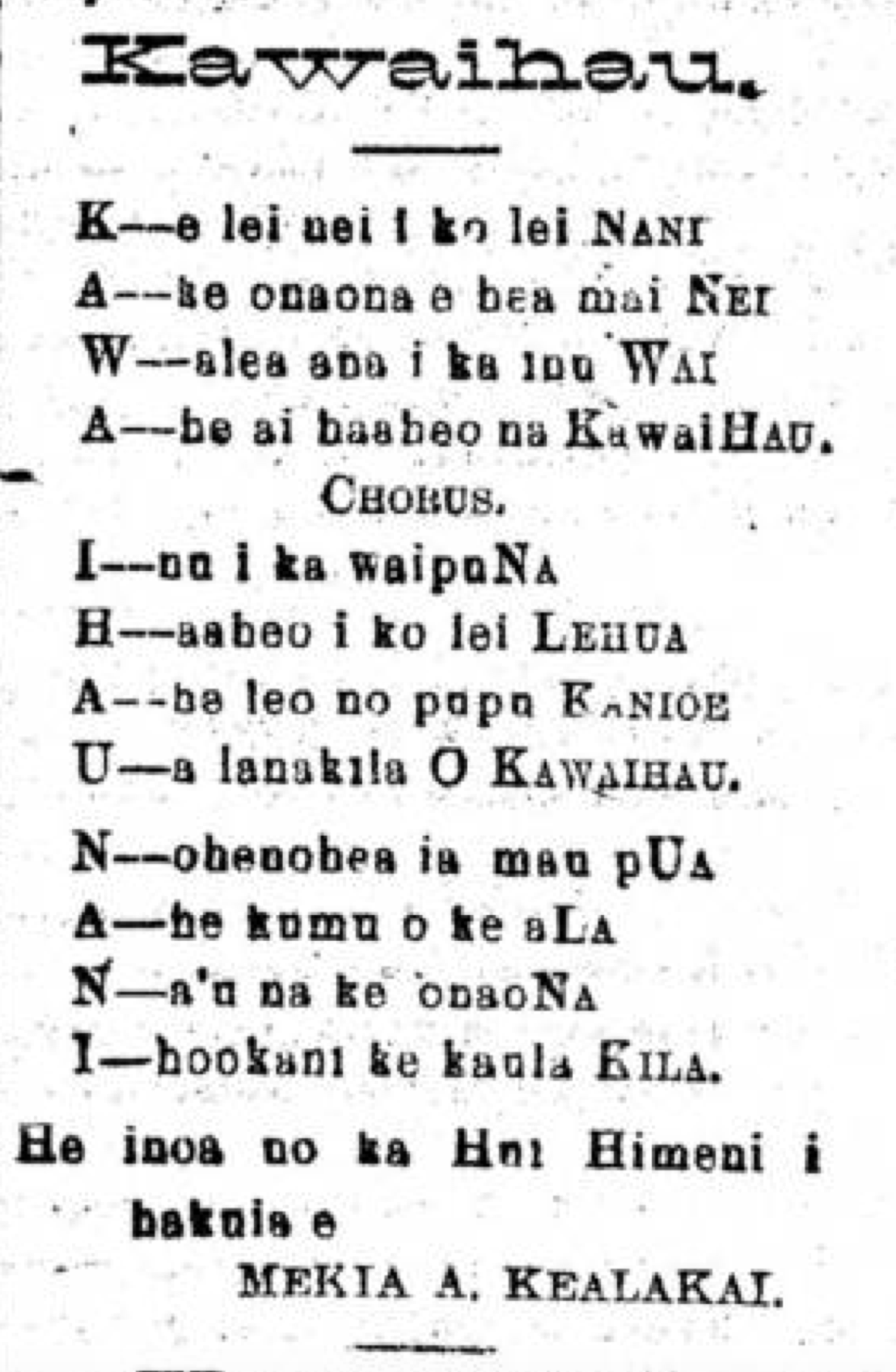
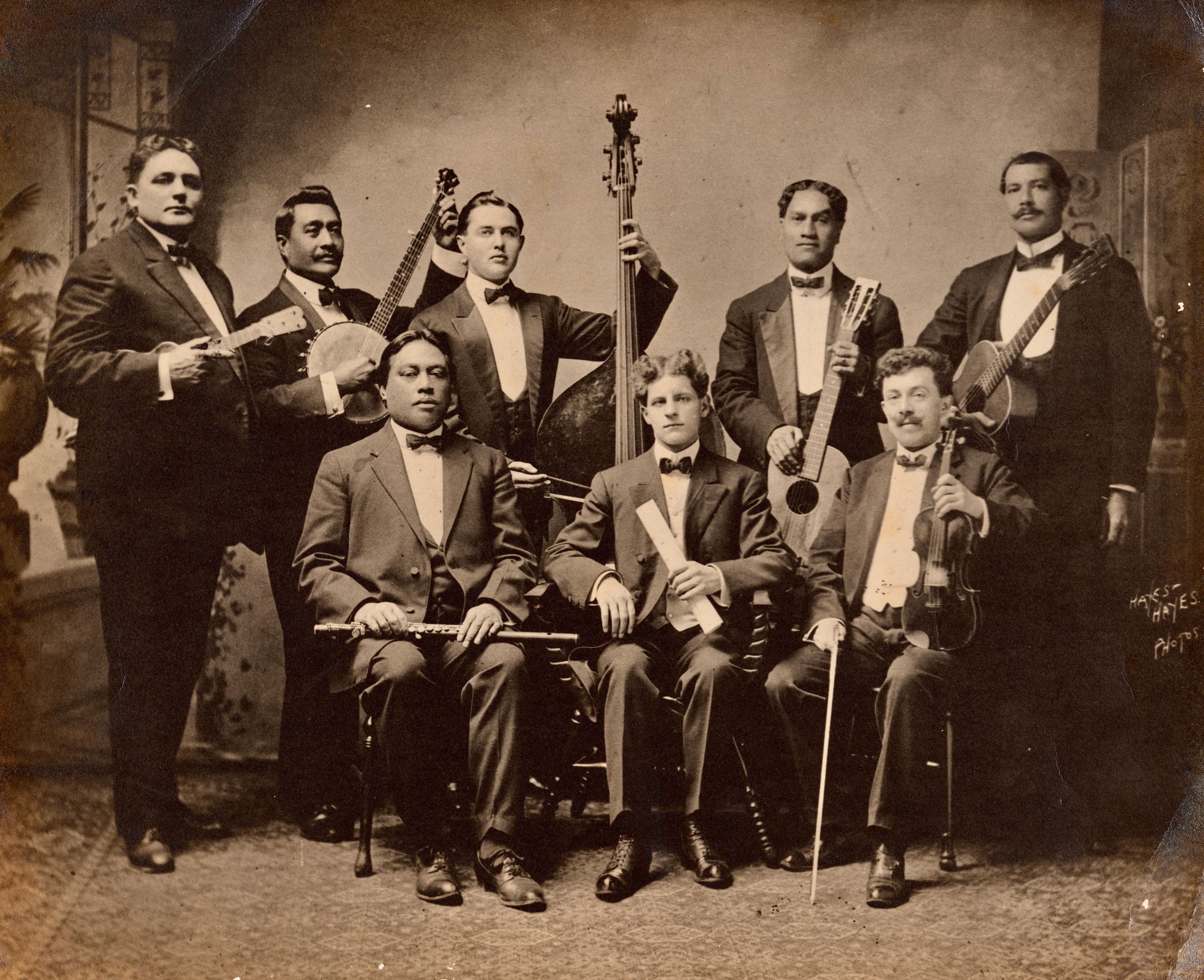
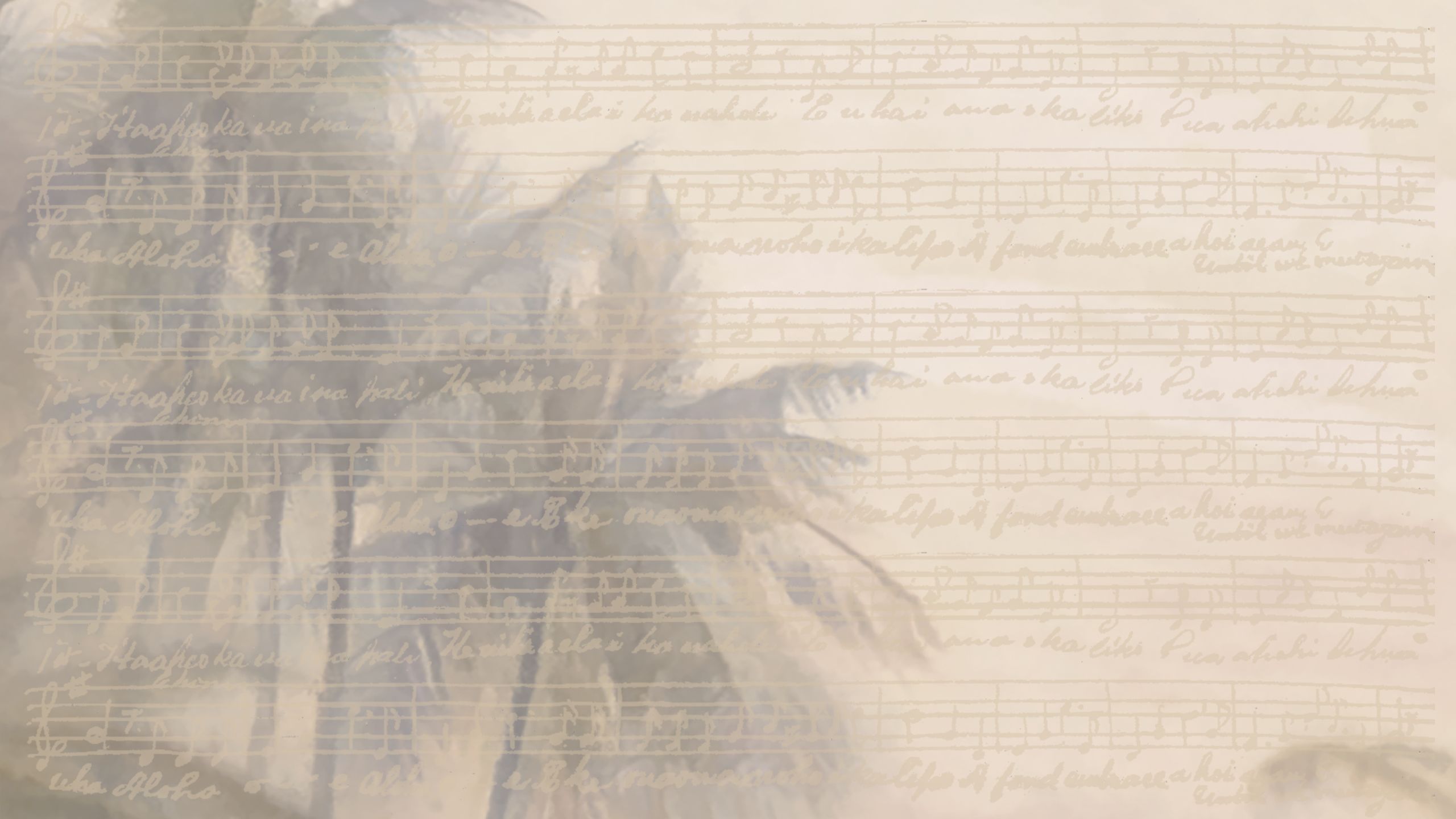
Lanakila Kawaihau
Mekia Kealakai
Ke lei nei i kō lei nani,
A ke onaona e hea mai nei,
(E) Walea ana i ka inu wai,
A he ʻai haʻaheo na Kawaihau
Hui:
Inu i ka wai māpuna,
Haʻaheo i kō lei lehua,
A he leo no pūpū kanioe,
Ua lanakila ʻo Kawaihau
Nohenohea ia mau pua,
A he kumu o ke ʻala,
Naʻu, na ke onaona,
I hoʻokani ke kaula kila
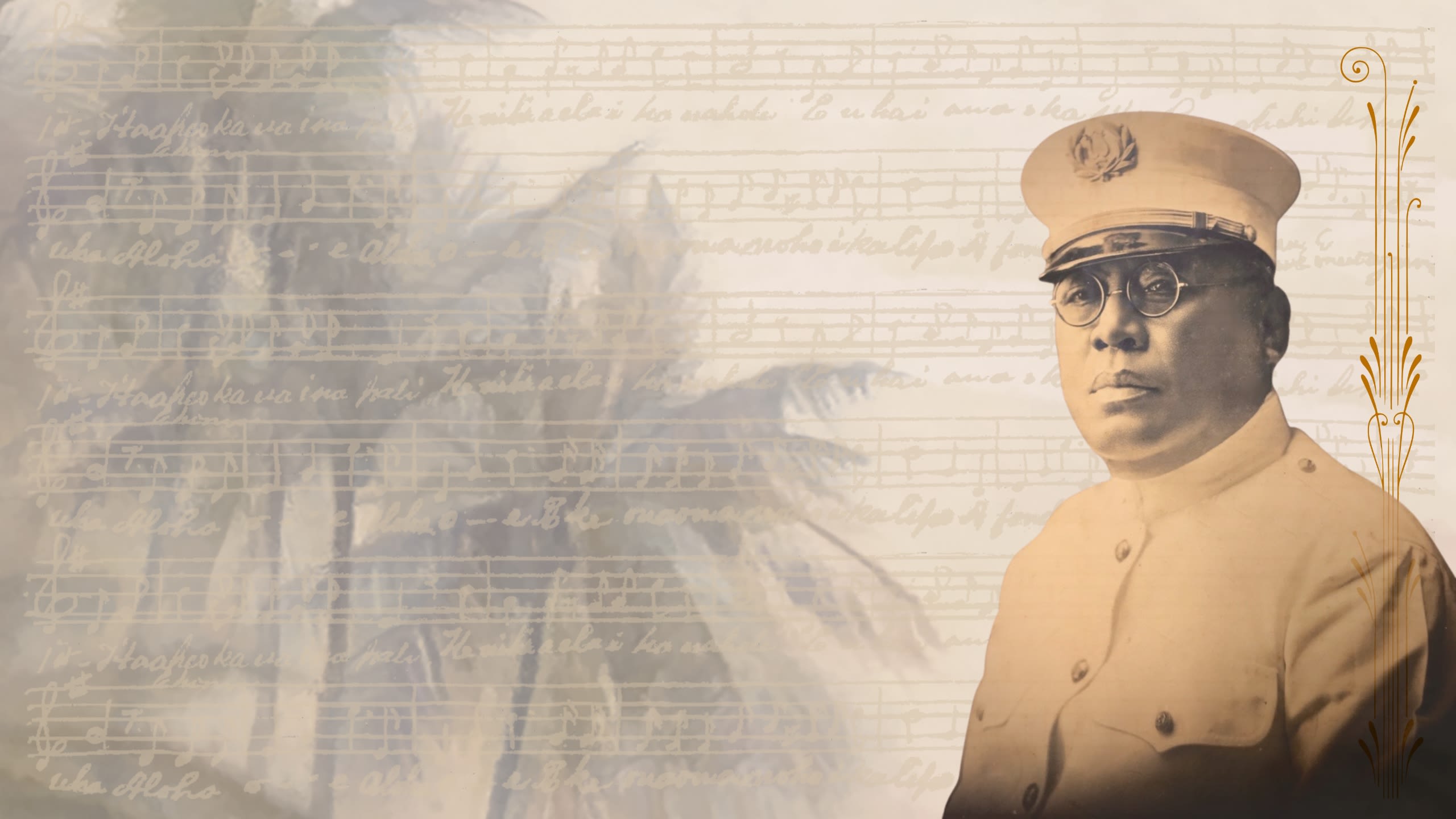
Nuʻuanu Waipuna
Mekia Kealakai likens Nuʻuanu’s fresh water springs to the abundance of aloha the composer holds for a lover. Building imagery and symbolism by referencing places, natural elements, and blossoms of the area, this mele pledges unending loyalty and cautions the sweetheart against covetousness and giving into physical desires.
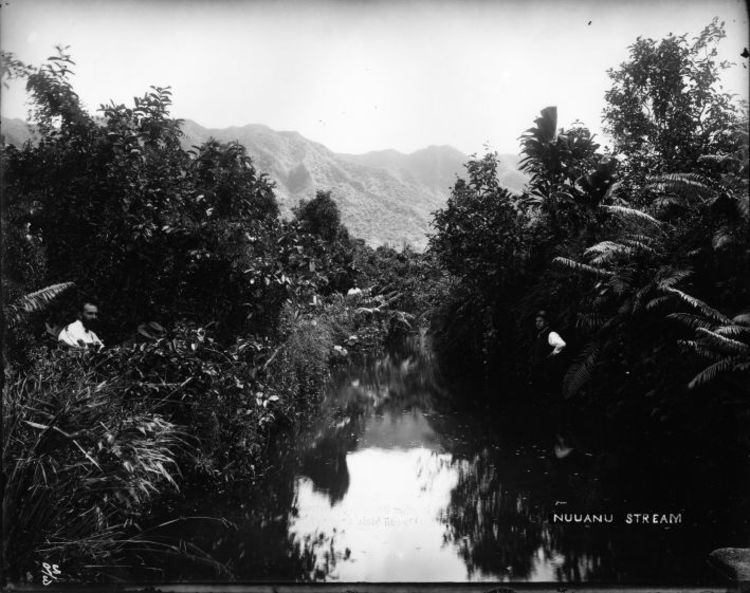

Nuʻuanu Waipuna
Mekia Kealakai
Mai hoʻohihi ʻoe, e ke onaona, I nā koʻiʻi a ke kino, I Waolani ʻoe e ʻike pono, Pili mai pumehana kāua.
Hui:
Nuʻuanu, waipuna a ke aloha, Kū kilakila i ka ua Pōpōkapa, Pūkuʻi kāua lā i laila, Kuʻu lei maʻo, ʻo ʻoe ia
He ʻiʻini kēia nou hoʻokahi, I ka ihu e hoʻomaʻū iho ai, Nou iho nei kuleana, Koali hoʻomaumau i ka piko

Nuʻuanu Waipuna
Be not overwhelmed, my sweet, By your physical desire. We will soon be together
and warm each other at Waolani.
Chorus:
Nuʻuanu is a well-spring of love, It stands majestically in the Pōpōkapa rain, We two will huddle together there, My maʻo- blossom lei, ʻtis you.
This desire is for you alone,
To wet your lips with a kiss, Here is your obligation, To be ever-entwined in my heart.
Keaoʻōpuaikamakaokanalu
In the album’s most recent composition, Kainani Kahaunaele offers Raiatea this mele inoa, a name song, in honor of Keaoʻōpuaikamakaokanalu. Weaving moʻokūʻauhau together with names of akua, aliʻi, and wahi pana, the composer conveys the mana associated with each onto the recipient of this inoa.
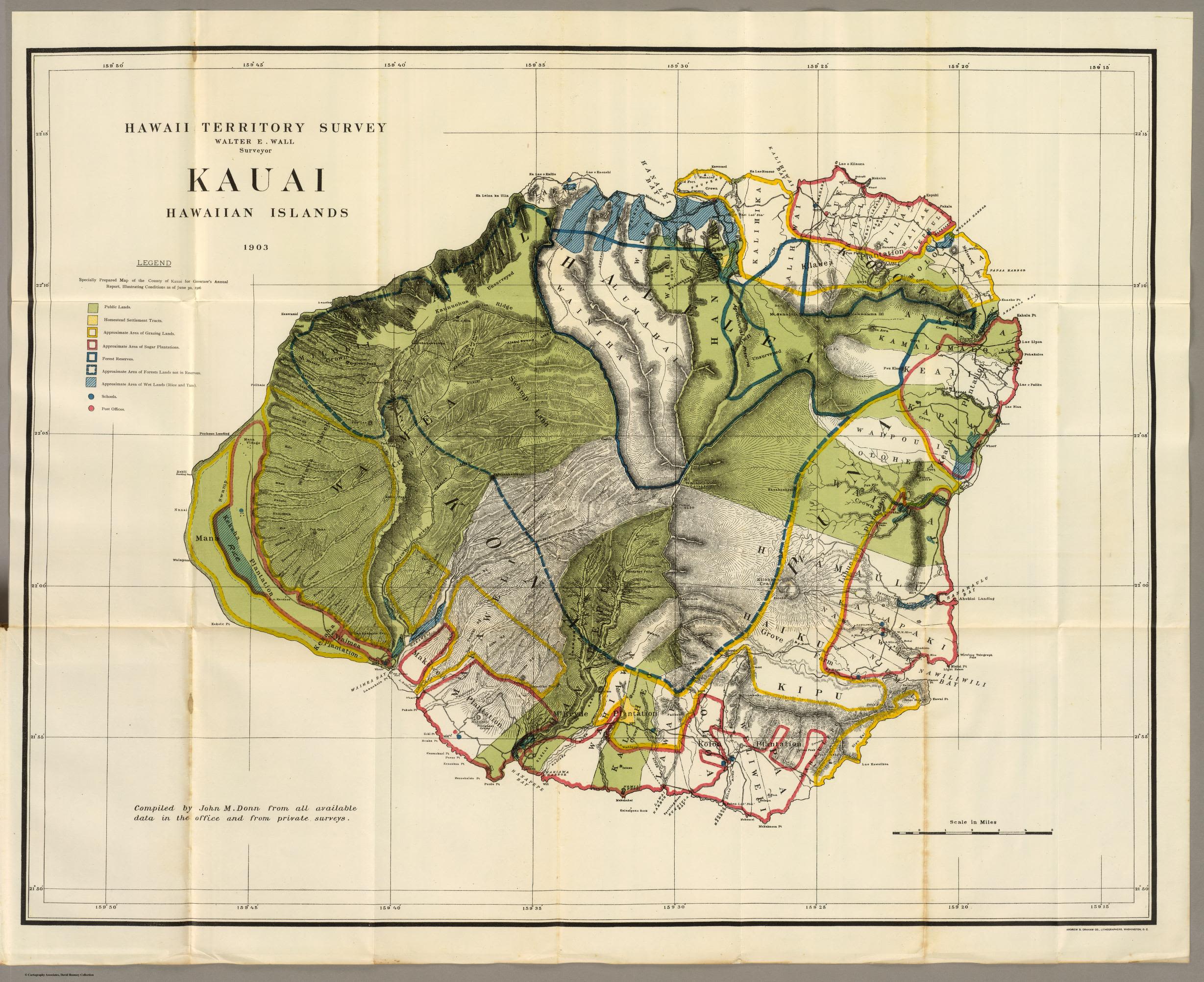
Keaoʻōpuaikamakaokanalu
Kainani Kahaunaele
Kaulana ʻo Kaʻili, Kaʻililauokekoa
I ka laulā o Puna, na Hoʻoipoikamalanai
Me Mōʻīkeha
Lamalama ka ʻili, lamalama maikaʻi
I ka pehia mau ʻia o kona pāpālina i ka hunahuna kai
O Makaiwa
Kani mai ana, Kanikawī ʻuheʻuhene
ʻO ia nō ʻoe ʻo ka nē hone a ka leo kolohala o ka pō laʻi
Ua lohe ʻia
Hui:
ʻAuhea wale ʻoe, Kauakahialiʻi
O ka wao ʻala kupaoa
O Pihanakalani
Eia hoʻi au
Inā kāua, heʻe ana i ka puʻeone
o Wailua, no Keaoʻōpuaikamakaokanalu
He inoa
No Keaoʻōpuaikamakaokanalu he inoa
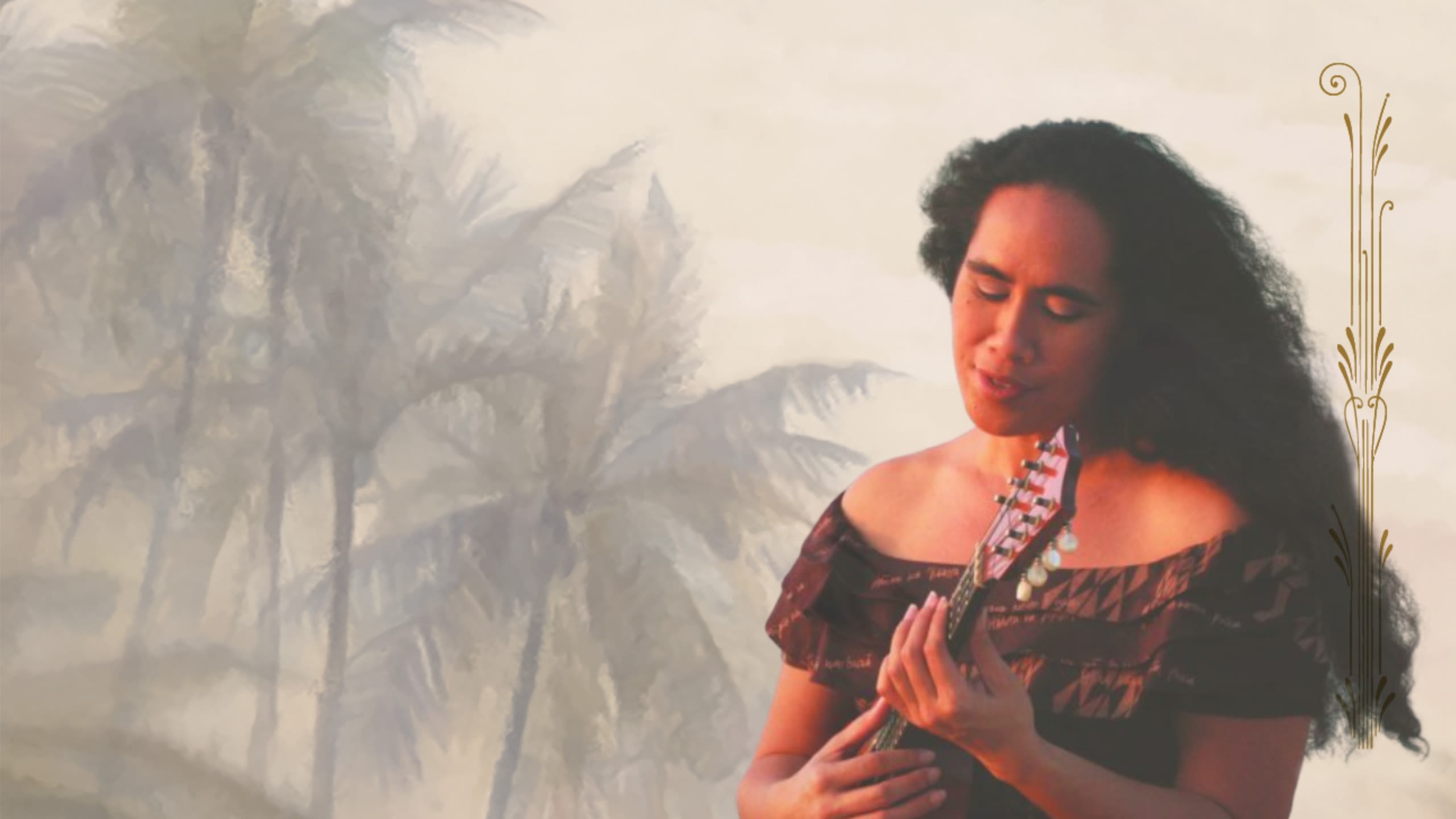
Kuʻu Ipo I Ka Heʻe Puʻe One
This compelling composition by Ke Kamāliʻi Miriam Likelike, the third sibling of Nā Lani ʻEhā, the Royal Four, alludes to the delights shared between two sweethearts, whose tryst seems to have a forlorn ending. The poetry draws upon sounds of the natural environment and other elemental forces to describe the physical sensations and emotional outcomes that befell the lovers in their pursuit of one another.
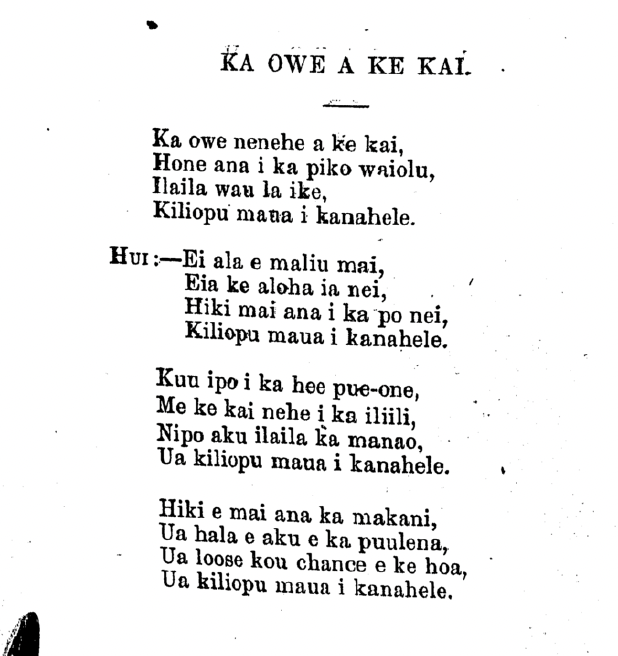

Kuʻu Ipo I Ka Heʻe Puʻe One
Princess Miriam Likelike
Kuʻu ipo i ka heʻe puʻe one
Me ke kai nehe i ka ʻiliʻili
Nipo aku i laila ka manaʻo
Ua kiliʻopu māua i ka nahele
Hui:
Eiā la e māliu mai
Eiā ko aloha i ʻaneʻi
Hiki mai ana i ka pō nei
Ua kiliʻopu māua i ka nahele
Ka ʻowē nenehe a ke kai
Hone ana i ka piko waiʻolu
I laila au la ʻike
Kiliʻopu māua i ka nahele
Hiki ʻē mai ana ka makani
Ua hala ʻē aku e ka Puʻulena
Ua lose kou chance e ke hoa
Ua kiliʻopu māua i ka nahele


Moani Ke ʻAla
Ke Keiki Aliʻi Leleiōhoku writes of a darling whose scent is carried on the breeze, attracting the frequent attention of a suitor. The lyrics teeter between flirtatious wooing and teasing vexation on the composer’s behalf, prompting a not-so rhetorical question: We have prepared for this moment well, why do you not avail yourself of our time together?
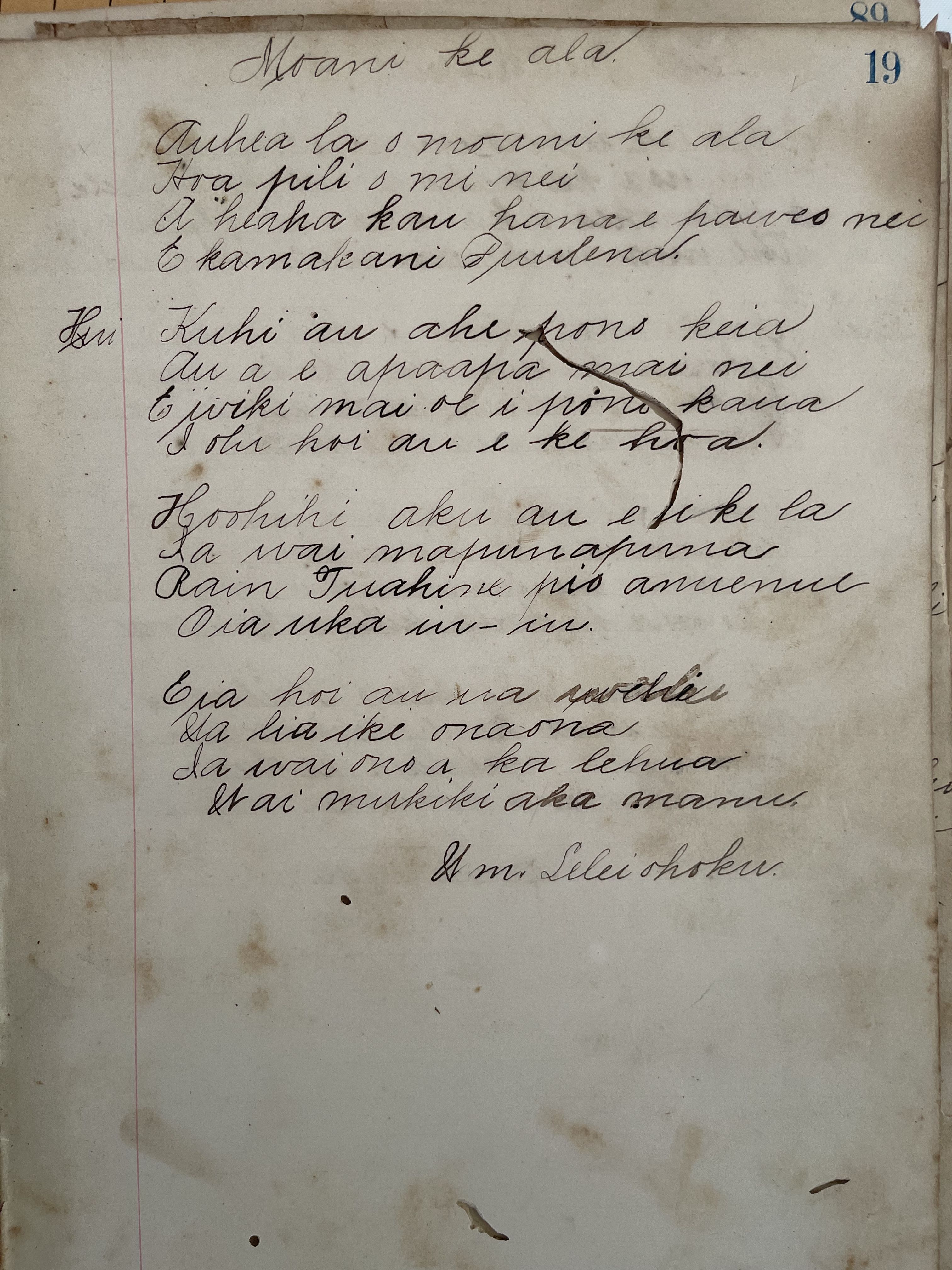

Moani Ke ʻAla
Prince William Pitt Leleiōhoku
ʻAuhea ʻo Moani keʻala
Hoa pili o mī nei
A he aha kāu hana e pāweo nei
E ka makani Puʻulena
Hui:
Kuhi au a he pono kēia
Āu e hoʻapaʻapa mai nei
E wiki mai ʻoe i pono kāua
I ʻolu hoʻi au e ke hoa
Hoʻohihi aku au e ʻike
I ka wai māpunapuna
Ua Tuahine piʻo ānuenue
O ia uka ʻiuʻiu Eia hoʻi au ua wehi
Ua liʻa ke onaona
Ia wai ʻona a ka lehua
Wai mūkīkī a ka manu
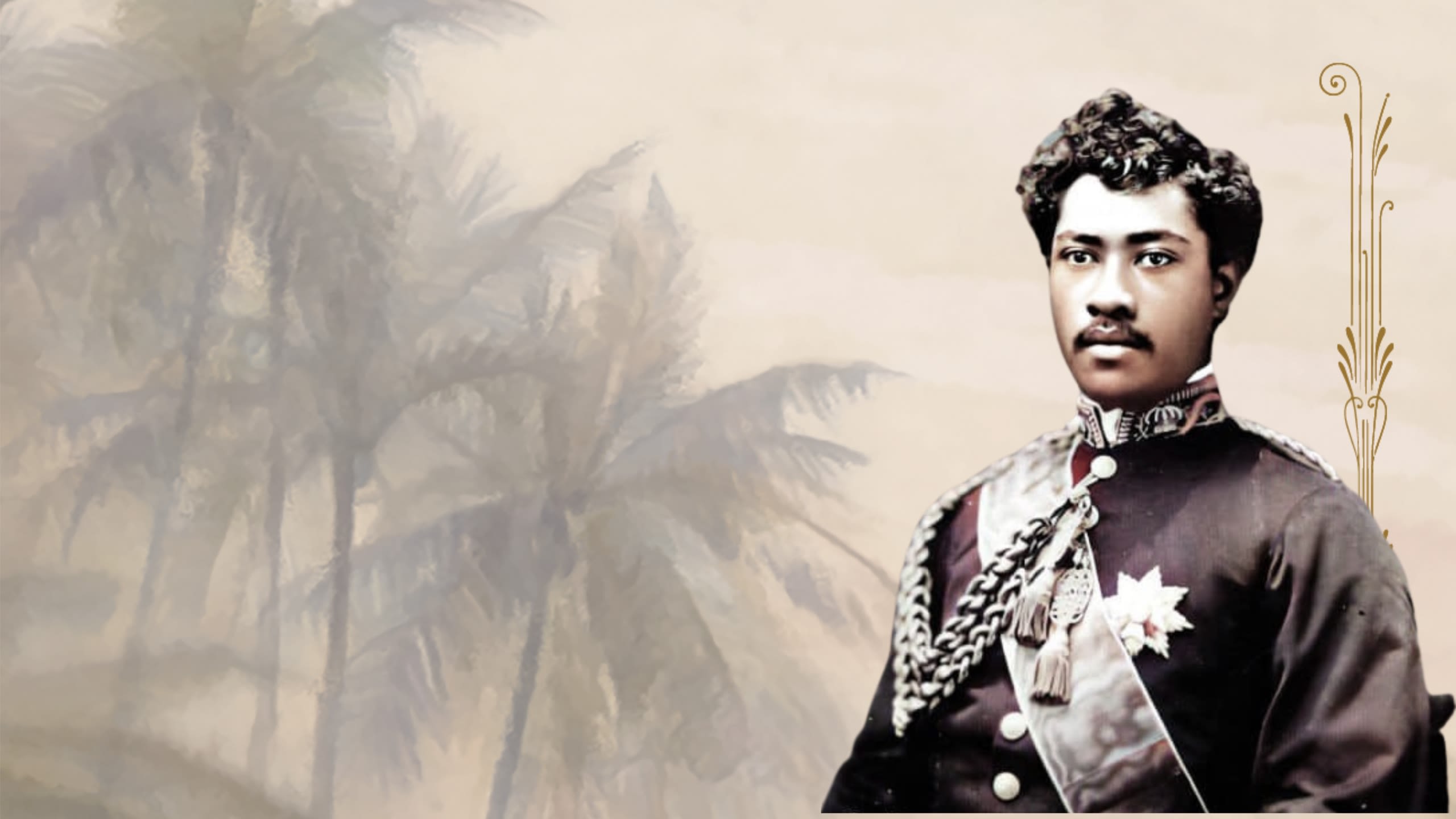
Nohea I Muʻolaulani
This plaintive melody conceals sentiments of everlasting affection and adoration for a dear one. Composed by Queen Liliʻuokalani, this mele seems to be Her Majesty’s pledge to look after and hold dear the subject of her poetry, whom she dons as a lei kaimana, a diamond necklace, gleaming most brightly among the innumerable royal buds at Muʻolaulani, the Queen Liliʻuokalani Children’s Center.
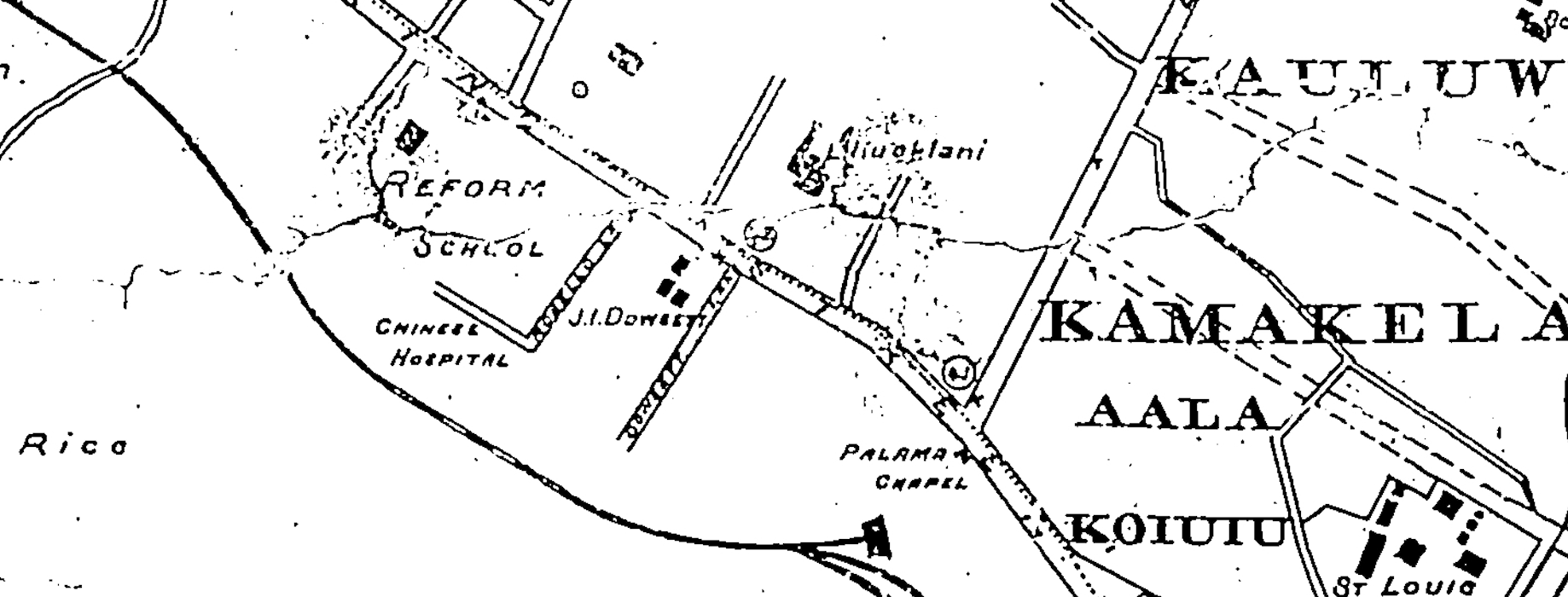

Nohea I Muʻolaulani
HRH Liliʻuokalani
He mea nui ke aloha
Ke hiki mai i oʻu nei
Meheʻo ku‘u lei kaimana ala
(Me he ‘ōpuʻu lei kaimana ala)
Kāhiko no kuʻu kino
Ku‘u lei popohe i ka la‘i
Nohea i Muʻolaulani
Ka beauty lā, he mau ia
No nā kau a kau
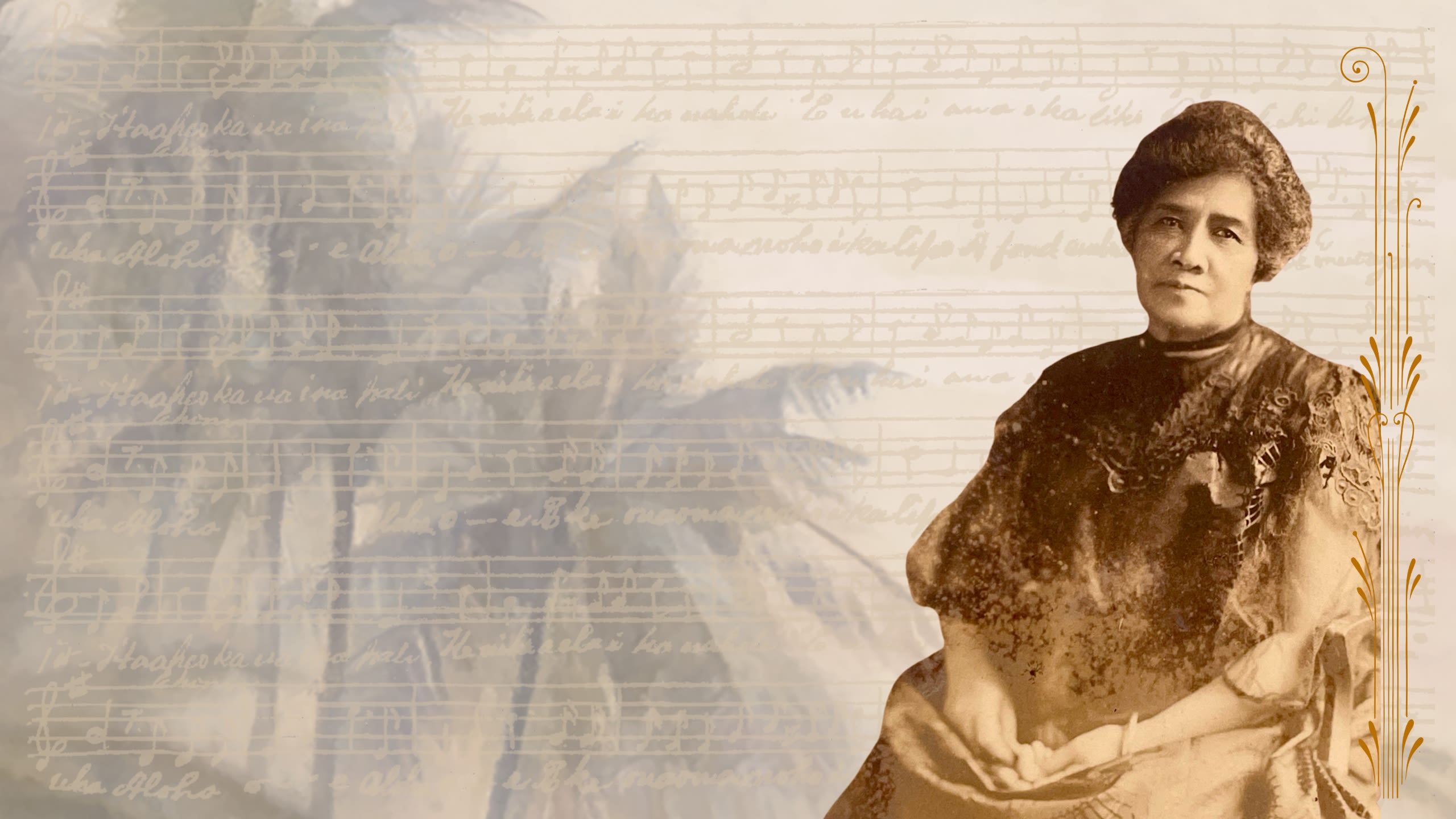
Nā Moku ʻEhā
Composer Johnny Kealoha is loyal to Hawaiian custom in his composition, acknowledging the four main islands, the different blossoms associated with them that are strung into lei, adorning each island’s tallest peak, respectively according them honor, splendor, pride, and renown. This mele has a mnemonic function by reminding us of important knowledge about our island home, such as words and imagery associated with nā moku ʻehā, the four islands.
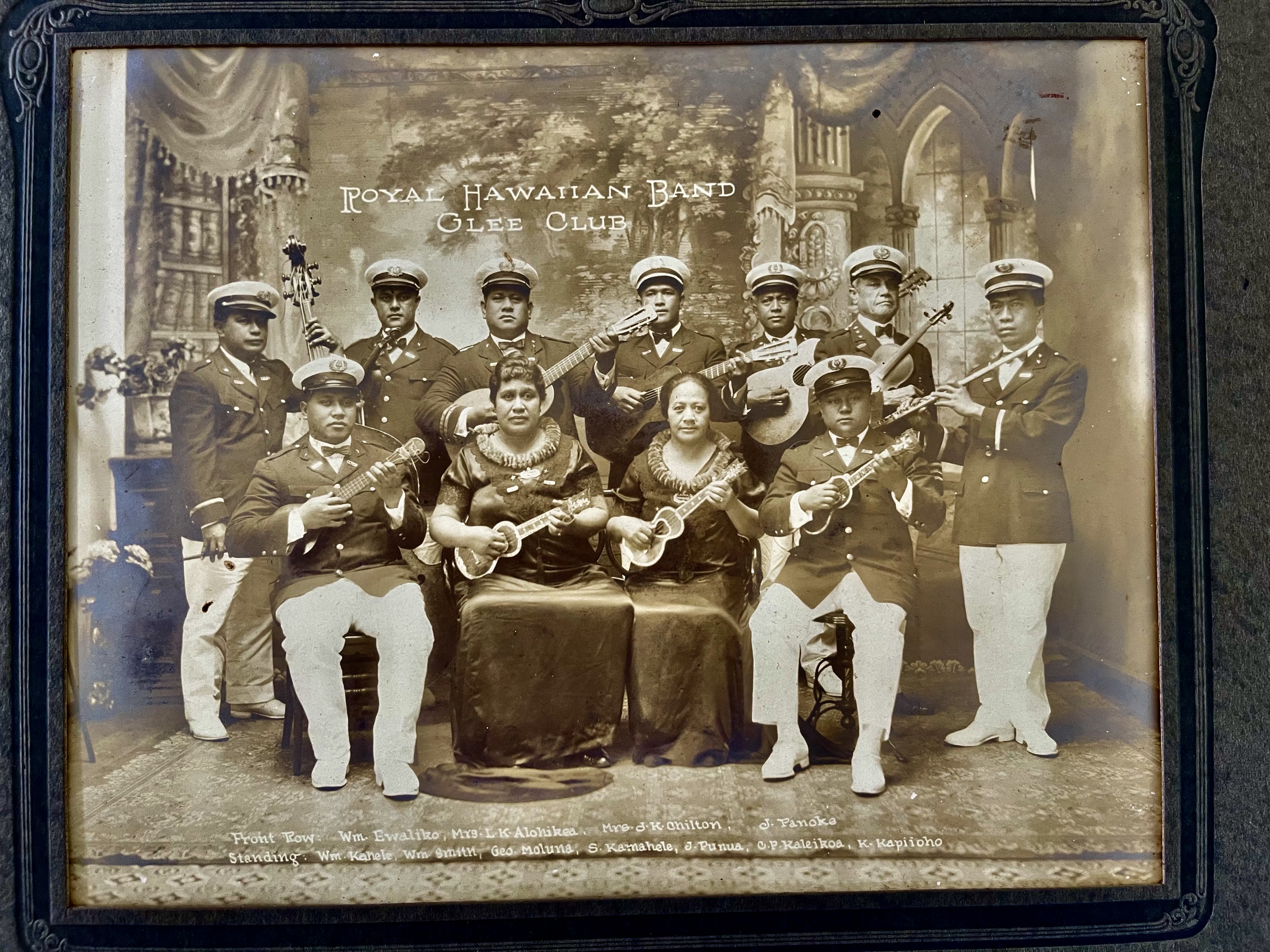

Nā Moku ʻEhā
Johnny Kealoha
Hanohano Hawaiʻi lā lei i ka lehua lā
Kuahiwi nani lā ʻo Mauna Kea
Kilakila ʻo Maui lā lei i ka roselani lā
Kuahiwi nani lā ʻo Haleakalā
Haʻaheo Oʻahu lā lei i ka ʻilima lā
Kuahiwi nani lā ʻo Kaʻala
Kaulana Kauaʻi lā lei mokihana lā
Kuahiwi nani lā ʻo Waiʻaleʻale
Haʻina ʻia mai ana ka puana lā
Kuahiwi nani lā ʻo nā moku ʻewalu
Haʻina ʻia mai ana ka puana lā
Nā moku ʻehā lā ʻo ka Pākīpika

Nā Moku ʻEhā
Honored is Hawaiʻi whose lei is the lehua
Beautiful is its mountain of Mauna Kea
Majestic is Maui whose lei is the roselani
Beautiful is its mountain of Haleakalā
Proud is Oʻahu whose lei is the ʻilima
Beautiful is its mountain of Kaʻala
Famous is Kauaʻi whose lei is the mokihana
Beautiful is its mountain of Waiʻaleʻale
Tell the refrain
Beautiful are the mountains of the eight islands
Tell the refrain
Of the four islands of the Pacific
Old Plantation
Love issues forth like the fragrance of blossoms at Old Plantation. In their mele, co-composers Mary Montano and David Nape revel in the warm hospitality of this home, now the current site of the Neal Blaisdell Center, whose amenities featured fish ponds, streams, and a water wheel. Sights, sounds, and senses experienced at the home become metaphors for fond memories held by intimates of the Ward ʻohana.


Old Plantation
Maryjane Montano & David Nape
Pua wale mai nō ke aloha
Ka paia puīa i ke ʻala
I ka wai huʻihuʻi aniani
Koʻiawe ka huila wai Aia i laila ka ʻiʻini
Ka ʻanoʻi a koʻu puʻuwai
Hui:
Old Plantation nani ʻoe
Home pumehana i ke aloha
I ka ʻolu o ka niu
I ka poli o ke onaona
Nahenahe ke ʻala o nā pua
I ka pēe ʻia e ke kēhau
Hoʻolaʻi nā manu i laila
Hoʻoipo i ke oho o ka niu
Luhe ehu ka palai i ka nuʻa
I ka ʻolu o ka Old Plantation
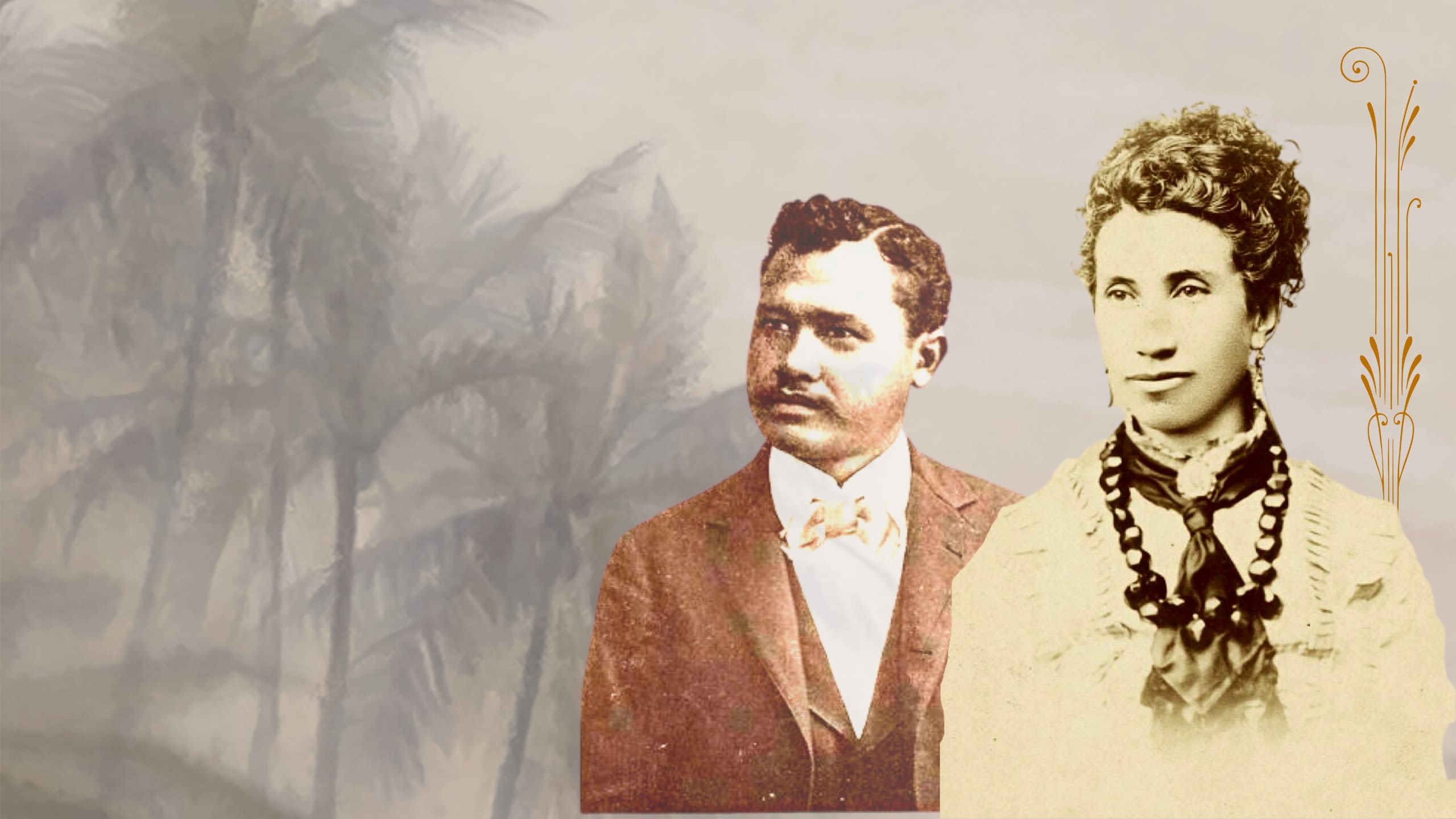
He Mele Lāhui Hawaiʻi
Her Majesty, Queen Liliʻuokalani, entreats Ka Makua Mana Loa to watch over the aliʻi of the aupuni, the makaʻāinana, and the lehulehu. The power and beauty of the queen’s poetry is in its intention, which she sets for the protection of each class of Hawaiʻi and its hierarchical society. This mele wishes blessings of prosperity and peace for the kingdom – from Hawaiʻi to Niʻihau – while conceiving an eternal reign for the mōʻī of the time, King Kamehameha V, whose livelihood is secured by the patience, affection, and shelter of the Almighty Father.
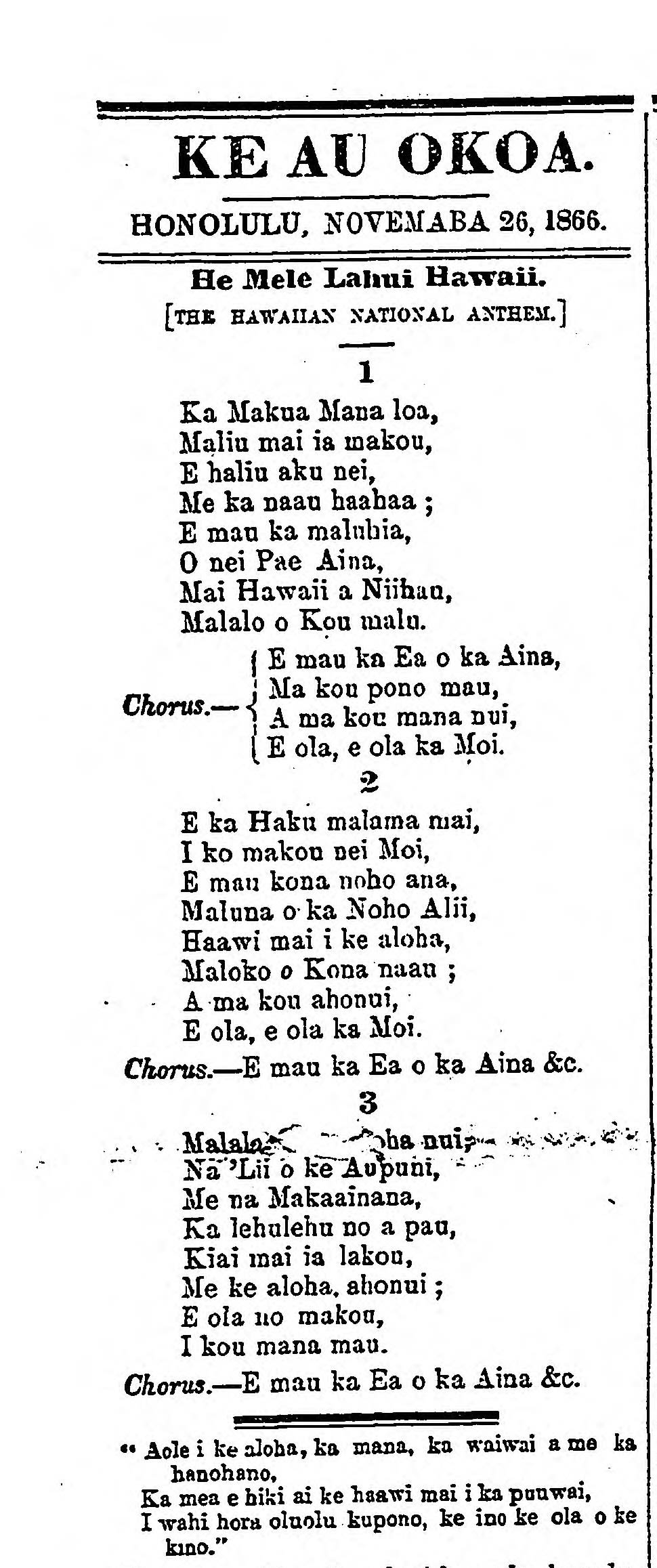

He Mele Lāhui Hawaiʻi
HRH Liliʻuokalani
Ka Makua Mana Loa
Maliu mai iā mākou
E hāliu aku nei
Me ka naʻau haʻahaʻa
E mau ka maluhia
O nei pae ʻāina
Mai Hawaiʻi a Niʻihau
Ma lalo o kou malu
Hui:
E mau ke ea o ka ʻāina
Ma kou pono mau
A ma kou mana nui
E ola, e ola ka mōʻī
E ka Haku, mālama mai
I ko mākou nei mōʻī
E mau kona noho ʻana
Ma luna o ka noho aliʻi
Hāʻawi mai i ke aloha
Ma loko o kona naʻau
A ma kou ahonui
E ola, e ola ka mōʻī
[Hoʻōho:] E mau ke ea
Ma lalo o kou aloha nui
Nā aliʻi o ke Aupuni
Me nā makaʻāinana
Ka lehulehu nō a pau
Kiaʻi mai iā lākou
Me ke aloha ahonui
E ola nō mākou
I kou mana mau
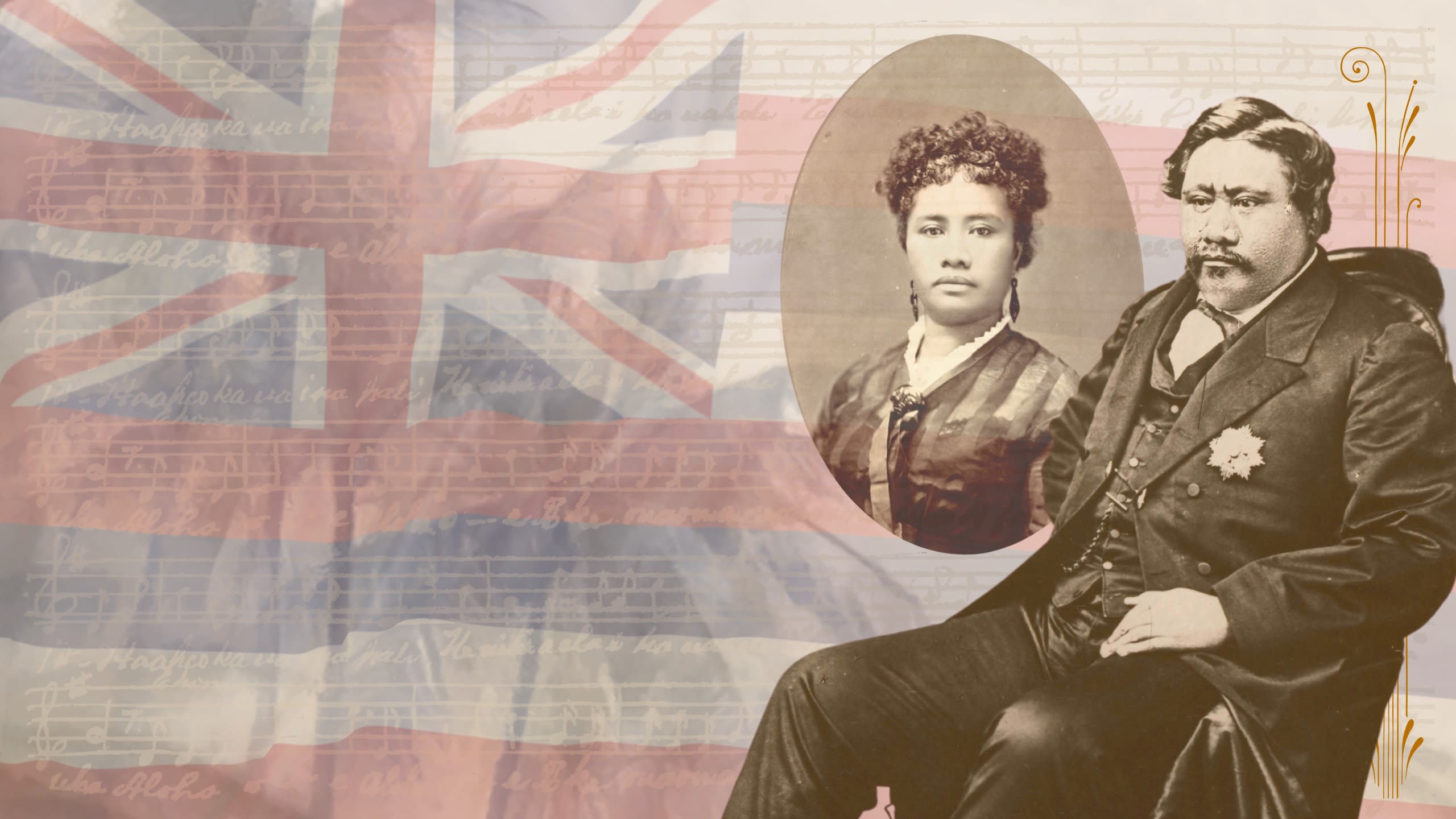
Mauna ʻAʻala
The imagery of this composition is illustrated by commending the features and characteristics of Mauna ʻAʻala to describe a person so lovely, their scent is carried on the breeze, whose effervescence was such that ilihia nā manu o ka laʻi, birds of the calm were still, pausing to behold such beauty. The composition also alludes to Lehua, likely a poetic reference to Mauna ‘Aʻala’s romantic companion.
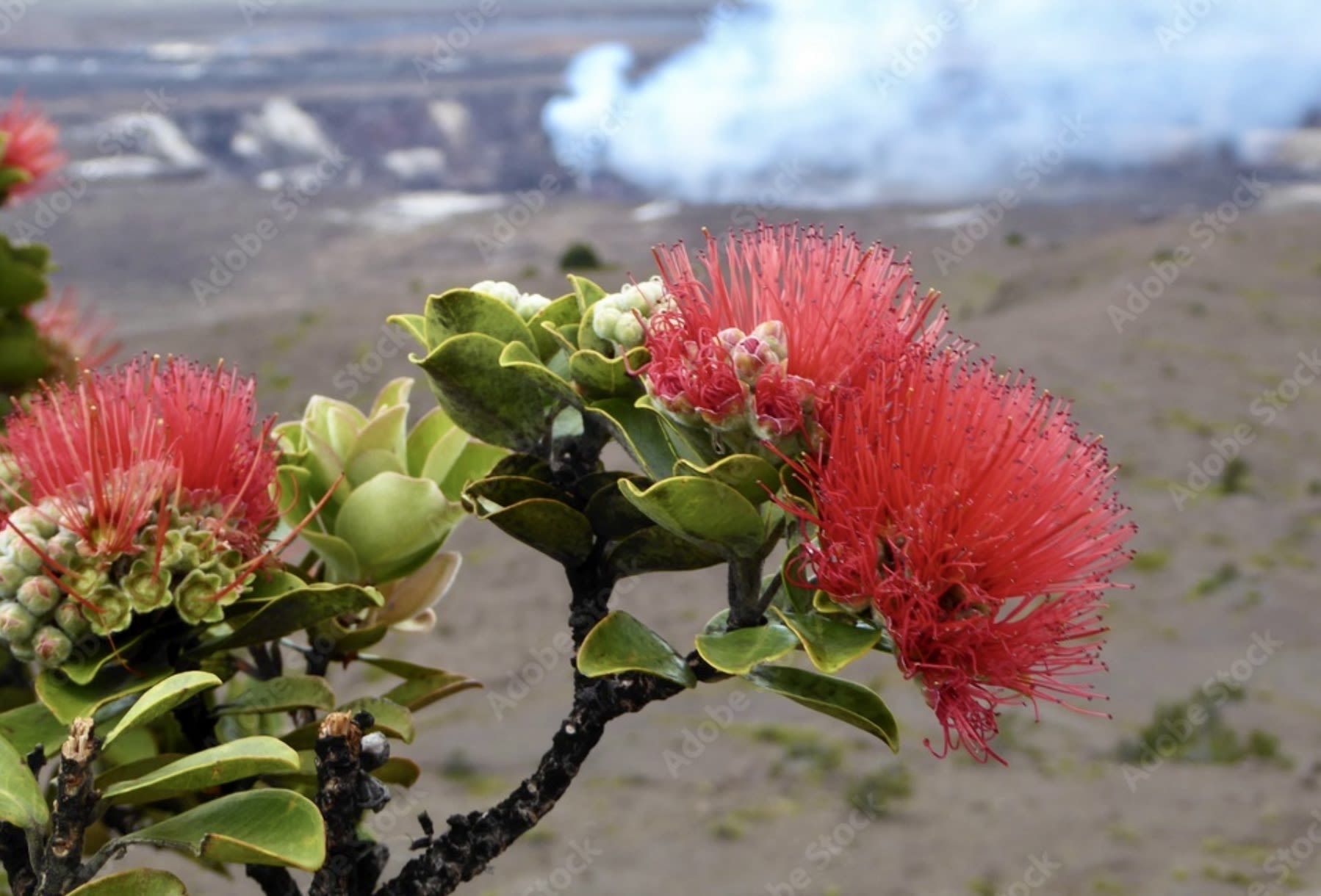

Mauna ʻAʻala
Mileina Ahia Mahelona & Maryjane Montano
A he aha kou makemake,
E Mauna ʻAʻala huʻihuʻi
E kō mai nei i ke ʻala o kō hanu
A ilihia nā manu o ka laʻi
Hui:
Wehiwehi ʻoe, e Mauna ʻAʻala
Ka huina o ke aloha me ke onaona
ʻAla ona paha na ke onaona
Ke ʻala i pili paʻa i ka pua
E moani ke ʻala nahenahe
Nowelo mālie i ka puʻuwai
A he waiwai ka pilina a ke aloha
I mehana i ka poli o Lehua

Mauna ʻAʻala
What is it you fancy,
O cool Mauna ʻAʻala
Who carries the scent of your essence hither
Enrapturing the birds into stillness
Chorus:
You are adorned in beauty, o Mauna ʻAʻala,
The combination of affection and loveliness
That must be the source of this sweet scent
The scent that clings to this blossom
Such sweet fragrance makes its way on the breeze
That gently finds its way into the heart
Being in love brings richness
To find warmth in the bosom of Lehua
Album Credits
Producers: Raiatea Helm, Kilin Reece, and Dave Tucciarone Partner: Kealakai Center for Pacific Strings
Graphic Design: Allison Leialoha Milham
Cover Image: Carol Nakamoto
Recorded At: Seventh Wave Studio
Liner Notes: Noah Haʻalilio Solomon
Digital Liner Notes Design & Layout: Kilin Reece and Allison Leialoha Milham
Engineered/Mixed/Mastered: Dave Tucciarone
Record Label: Raiatea Helm Records, LLC
Digital Distribution: Mountain Apple Company
String Arrangements: Maestro Aaron Mahi & Duane Padilla Song Arrangers: Jeff Peterson and Kamakoa Asing
Composer of original works: Kainani Kahauanaele
Guitar: Kamakoa Asing, Jeff Peterson and Joe Zayac
Upright Bass: Jeff Au Hoy and Kamakoa Asing
Hawaiian Steel guitar: Casey Olsen
ʻUkulele: Kamakoa Asing and Ian OʻSullivan
Flute: Lance Suzuki
Autoharp: Ledward Kaapana
Piano: Dan Del Negro and Aaron Salā
Dobro: Rob Ickes
Fiddle: Eli Bishop and Justin Branum
Violin: Eric Silberger and Mann-Wen Lo
Viola: Duane Padilla
Cello: Josh Nakazawa
